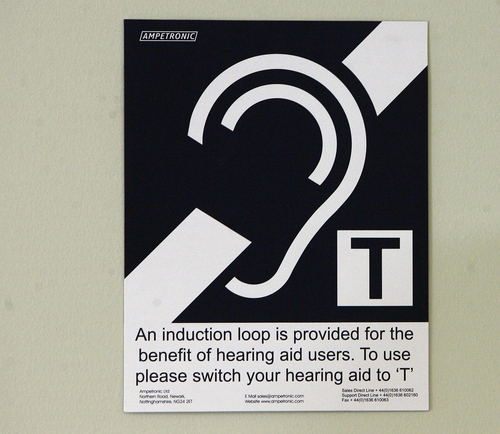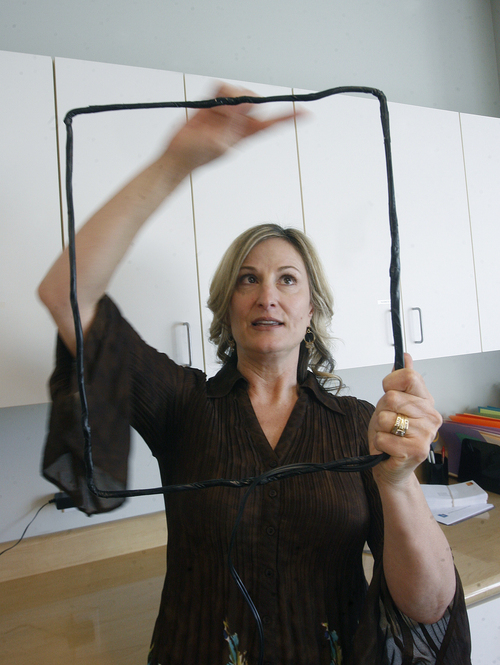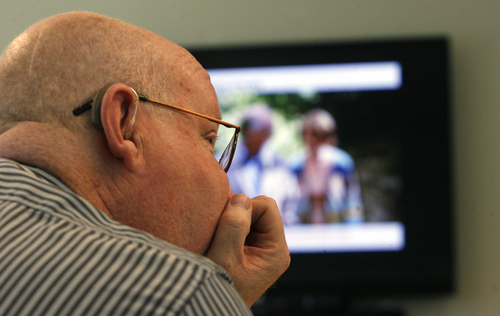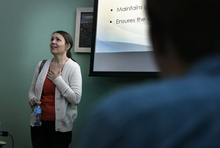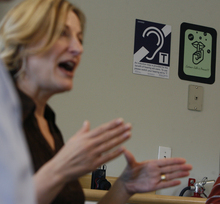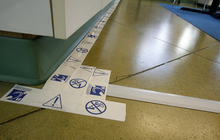This is an archived article that was published on sltrib.com in 2013, and information in the article may be outdated. It is provided only for personal research purposes and may not be reprinted.
Bluffdale • Like many people who are hearing impaired, Kristel Scoresby and Steve Brantley spend much of their lives faking it. They simply smile and nod their heads in social situations, often doing such a good job that the people speaking to them don't realize that they are not being heard.
A hearing technology called "the loop" that has been in use in Europe for 45 years may help to change that if a Utah-based company called Listen Technologies can get the system installed in movie theaters, restaurants, concert halls, churches, convention centers and even ticket counters and taxis.
According to the company, which is marketing the European loop system as well as more traditional hearing devices that utilize either radio wave or infrared technologies, hearing loop technology consists of a sound system connected to a wire or induction loop that circles a specific area in a venue.
The loop transmits the sound electromagnetically and the signal is picked up by a telecoil, commonly called a t-coil, which is a small magnetic coil housed within about 70 percent of the hearing aids sold in the United States. The coils, which are activated by simply pushing a small button on the hearing aid, allow users to receive clear sound directly through the circuitry of the hearing aid.
According to Listen co-founder Cory Schaeffer, the loop can go into a floor. In new construction, it is usually laid in concrete. But it can go under carpet as well. The cost of the gear runs between $800 and $1,000 with an additional cost to install it.
Brantley and Scoresby say the difference the system makes is life-changing.
"Television, radio, the telephone, works with the loop if you have it," said Brantley, who lives in South Jordan. "With one-on-one conversations, that's amazing."
Brantley also uses a neck loop that helps him hear on the phone and in his job as a legal researcher.
Scoresby, a Springville mother of three youngsters and a social worker, has heard through a cochlear implant since 2012.
"I've had hearing loss since I was 4," she said. "I started using hearing aids at age 12. I did the implant on one side, which provides more effective hearing once hearing aids become ineffective. It's been amazing."
That is especially true in Scoresby's field of social work, where listening is a key component of therapy. She tells of the frustration of trying to help a co-worker locate a client who was contemplating suicide and, when handed the phone, not being able to hear the troubled person.
Schaeffer said Listen was founded in 1998 to offer assistive listening devices that could change lives.
The company has 50 employees. The loop system it is marketing is made by Ampetronic, a European company that is a world leader in the technology.
"It's not about the technology," said Schaeffer. "It's all about the installation. That's what matters."
Scoresby experienced the benefits of the loop system first hand when she took a trip to London. She was apprehensive when she went to a ticket office, fearing she would not be able to understand the instructions. But, due to the system, she could hear clearly. The system is used at ticket counters, in airports and in many public places throughout Europe. It is even used on some tour buses.
"I so wish we could do that here," she said.
Brantley said going to movies is a waste of money and that background noise in many public places is beyond frustrating.
Schaeffer said the loop hearing system is being used in many venues throughout the United States, but few in Utah, even though the Americans with Disability Act requires new buildings to be equipped with devices to help the 36 million Americans who suffer from hearing loss. That's about 17 percent of the population.
Scoresby recently headed a Loop Utah Movement festival to kick of an ongoing advocacy campaign dedicated to educating Utah venues about the many benefits that can come from using hearing loop technology.
She is hoping that new building construction such as the Capitol Theater or the new Hale Center Theater planned in Sandy can utilize the loop technology to help people who have trouble hearing enjoy entertainment.
That might be more common, since the Americans with Disabilities Act was updated with new regulations in 2010 regarding assistive listening devices. As of March 15, 2012, those devices are now mandatory for all new construction and alterations.
If that includes more loop technology in public buildings, people such as Brantley and Scoresby who have struggled to hear for years might no longer be required to fake it.
Twitter: @tribtomwharton —
How Loop technology works
1 • Audio inputs, either from an existing audio source such as a public address system or from dedicated microphone inputs, feed an audio signal into an Induction Loop Amplifier.
2 • The amplifier drives a current into a loop or series of loops.
3 • As the current flows through the cable, it creates a magnetic field in the required area.
4 • Careful loop and amplifier design ensures that the vertical component of the field is even and free of dropouts and dead zones wherever the user might be.
5 • Inside most hearing aids, a small coil known as a telecoil picks up the magnetic field signal, which is amplified into a high quality audio signal delivered directly to the ear of the hearing aid user.
Source: Ampetronic



